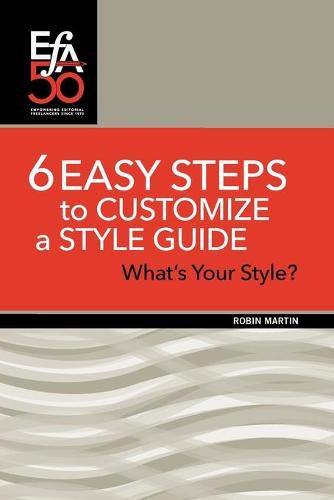Readings Newsletter
Become a Readings Member to make your shopping experience even easier.
Sign in or sign up for free!
You’re not far away from qualifying for FREE standard shipping within Australia
You’ve qualified for FREE standard shipping within Australia
The cart is loading…






This title is printed to order. This book may have been self-published. If so, we cannot guarantee the quality of the content. In the main most books will have gone through the editing process however some may not. We therefore suggest that you be aware of this before ordering this book. If in doubt check either the author or publisher’s details as we are unable to accept any returns unless they are faulty. Please contact us if you have any questions.
For editors of content for print, digital, and the internet, this booklet teaches six steps to easily customize a style guide for published content.
A publishing house, journalism outlet, corporation, sole proprietor, or the like, wanting to assure consistency in their brand and writerly voice, maintains a house style guide reflecting their official grammatical, mechanical, usage, and design preferences for the writing they produce. A consistent house style is a kind of contract with the reader, designed with them in mind. There are a handful of common style guides designed to suit the fields in which they are used.
The author of this booklet, Robin Martin, has eleven years’ experience customizing style guides as a freelancer and as the managing editor of a literary magazine. One of her projects was as a volunteer at the EFA, collaborating with other stakeholders to generate a house style for the organization. She has taught MLA, AP, and CMOS styles to students, and worked with each of these style guides online as well as in print.
Rules of grammar and usage may be prescriptive or descriptive, and there are differences among reference books, dictionaries, and other respectable sources. The intention of this booklet is not to elevate one over another or to suggest an open disregard to established guides, rather it is to recommend approaching style with an open mind. The author presumes not only the freedom to customize, but the obligation to customize with the needs of the rhetorical situation at the forefront.
A handful of core best practices carry over from one project to the next and make customization of style guides quite simple. This booklet for copyeditors sets out and delves into six steps to easily customize a style guide for a client’s content. Step one is establishing the rhetorical situation, step two is identifying and mapping patterns, step three is querying the author of the work, step four is structuring and formatting the guide, step five is applying the style to the work, step six is adjusting and refining the style guide.
A style guide should be seen as a living, breathing, document that ensures intention and consistency throughout the entirety of a client’s content.
$9.00 standard shipping within Australia
FREE standard shipping within Australia for orders over $100.00
Express & International shipping calculated at checkout
This title is printed to order. This book may have been self-published. If so, we cannot guarantee the quality of the content. In the main most books will have gone through the editing process however some may not. We therefore suggest that you be aware of this before ordering this book. If in doubt check either the author or publisher’s details as we are unable to accept any returns unless they are faulty. Please contact us if you have any questions.
For editors of content for print, digital, and the internet, this booklet teaches six steps to easily customize a style guide for published content.
A publishing house, journalism outlet, corporation, sole proprietor, or the like, wanting to assure consistency in their brand and writerly voice, maintains a house style guide reflecting their official grammatical, mechanical, usage, and design preferences for the writing they produce. A consistent house style is a kind of contract with the reader, designed with them in mind. There are a handful of common style guides designed to suit the fields in which they are used.
The author of this booklet, Robin Martin, has eleven years’ experience customizing style guides as a freelancer and as the managing editor of a literary magazine. One of her projects was as a volunteer at the EFA, collaborating with other stakeholders to generate a house style for the organization. She has taught MLA, AP, and CMOS styles to students, and worked with each of these style guides online as well as in print.
Rules of grammar and usage may be prescriptive or descriptive, and there are differences among reference books, dictionaries, and other respectable sources. The intention of this booklet is not to elevate one over another or to suggest an open disregard to established guides, rather it is to recommend approaching style with an open mind. The author presumes not only the freedom to customize, but the obligation to customize with the needs of the rhetorical situation at the forefront.
A handful of core best practices carry over from one project to the next and make customization of style guides quite simple. This booklet for copyeditors sets out and delves into six steps to easily customize a style guide for a client’s content. Step one is establishing the rhetorical situation, step two is identifying and mapping patterns, step three is querying the author of the work, step four is structuring and formatting the guide, step five is applying the style to the work, step six is adjusting and refining the style guide.
A style guide should be seen as a living, breathing, document that ensures intention and consistency throughout the entirety of a client’s content.